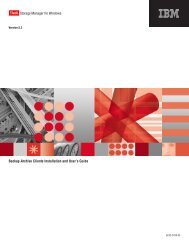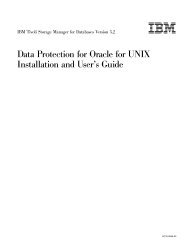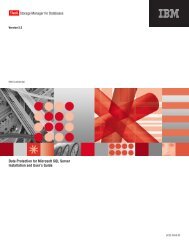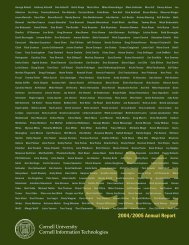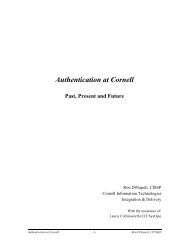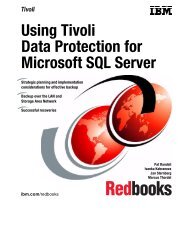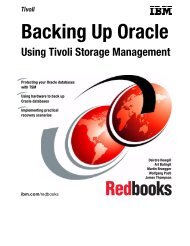Installation and User's Guide - Services and Support
Installation and User's Guide - Services and Support
Installation and User's Guide - Services and Support
Create successful ePaper yourself
Turn your PDF publications into a flip-book with our unique Google optimized e-Paper software.
IBM ConfidentialWhen using multiple simultaneous instances of Data Protection forExchange to perform operations, use the /logfile parameter to specify adifferent log file for each instance used. This directs logging for eachinstance to a different log file <strong>and</strong> prevents interspersed log file records.Failure to specify a different log file for each instance can result inunreadable log files./LOGPrune=numdays|NoUse the /logprune parameter to disable log pruning or to explicitly requesta prune of the log for one comm<strong>and</strong> run. By default, log pruning isenabled <strong>and</strong> performed once per day. The numdays variable represents thenumber of days to save log entries. By default, 60 days of log entries aresaved in the prune process. You can use the Data Protection for ExchangeGUI or the set comm<strong>and</strong> to change the defaults so that log pruning isdisabled, or so that more or less days of log entries are saved. Thecomm<strong>and</strong> line user may use the /logprune parameter to override thesedefaults for one comm<strong>and</strong> run. Note that when the value of the /logprunevariable numdays is a number in the range 0 to 9999, a prune is performedeven if one has already been performed for the day.Changes to the value of the timeformat or dateformat parameter can resultin an undesired pruning of the Data Protection for Exchange log file. If youare running a comm<strong>and</strong> that may prune the log file <strong>and</strong> the value of thetimeformat or dateformat parameter has changed, perform one of thefollowing to prevent undesired pruning of the log file:v Make a copy of the existing log file.v Specify a new log file with the /logfile parameter or logfile setting./TSMNODe=tsmnodenameThe tsmnodename variable refers to the Tivoli Storage Manager node nameData Protection for Exchange uses to log on to the Tivoli Storage Managerserver. You can also store the node name in the Tivoli Storage Manageroptions file. The comm<strong>and</strong> line parameter overrides the value in the TivoliStorage Manager options file if PASSWORDACCESS is set to PROMPT.This parameter is not valid when PASSWORDACCESS is set toGENERATE./TSMOPTFile=tsmoptfilenameThe tsmoptfilename variable identifies the Data Protection for Exchangeoptions file.The file name can include a fully qualified path name. If no path isspecified, the directory where Data Protection for Exchange is installed issearched.If the tsmoptfilename variable includes spaces, the entire /tsmoptfileparameter entry must be placed in double quotes. For example:/TSMOPTFile="c:\Program Files\file.opt"The default is dsm.opt.ChangetsmpasswordExampleThese output example provides a sample of the text, messages, <strong>and</strong> process statusthat displays when using the changetsmpassword comm<strong>and</strong>.The tdpexcc changetsmpassword oldpw newpw newpw comm<strong>and</strong> changes theTivoli Storage Manager password used by Data Protection for Exchange. Anexample of the output is displayed below.Chapter 5. Using the Comm<strong>and</strong> Line Interface 105



